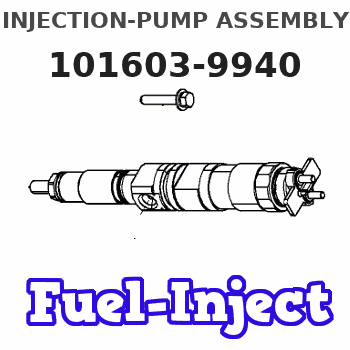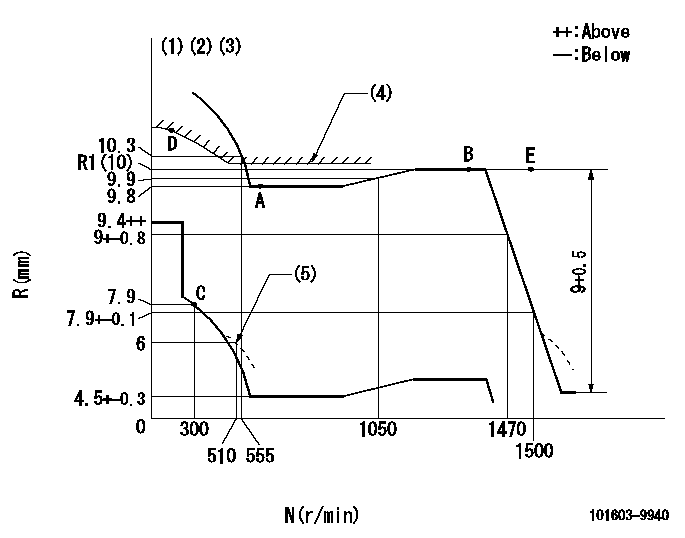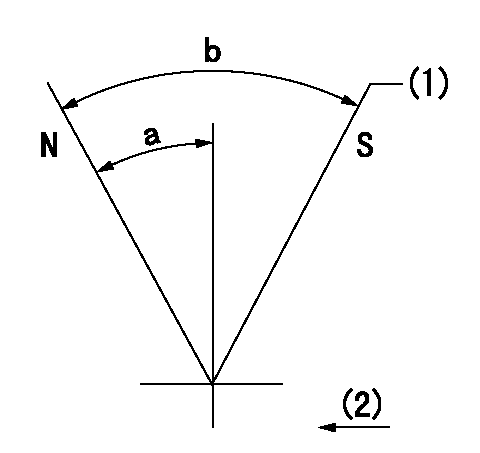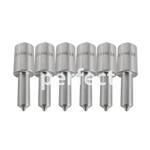Information injection-pump assembly
BOSCH
F 019 Z10 833
f019z10833
ZEXEL
101603-9940
1016039940

Rating:
Service parts 101603-9940 INJECTION-PUMP ASSEMBLY:
1.
_
7.
COUPLING PLATE
8.
_
9.
_
11.
Nozzle and Holder
16600Z5519
12.
Open Pre:MPa(Kqf/cm2)
19.6(200)
15.
NOZZLE SET
Include in #1:
101603-9940
as INJECTION-PUMP ASSEMBLY
Include in #2:
104740-1960
as _
Cross reference number
BOSCH
F 019 Z10 833
f019z10833
ZEXEL
101603-9940
1016039940
Zexel num
Bosch num
Firm num
Name
Calibration Data:
Adjustment conditions
Test oil
1404 Test oil ISO4113 or {SAEJ967d}
1404 Test oil ISO4113 or {SAEJ967d}
Test oil temperature
degC
40
40
45
Nozzle and nozzle holder
105780-8140
Bosch type code
EF8511/9A
Nozzle
105780-0000
Bosch type code
DN12SD12T
Nozzle holder
105780-2080
Bosch type code
EF8511/9
Opening pressure
MPa
17.2
Opening pressure
kgf/cm2
175
Injection pipe
Outer diameter - inner diameter - length (mm) mm 6-2-600
Outer diameter - inner diameter - length (mm) mm 6-2-600
Overflow valve opening pressure
kPa
157
123
191
Overflow valve opening pressure
kgf/cm2
1.6
1.25
1.95
Tester oil delivery pressure
kPa
157
157
157
Tester oil delivery pressure
kgf/cm2
1.6
1.6
1.6
Direction of rotation (viewed from drive side)
Right R
Right R
Injection timing adjustment
Direction of rotation (viewed from drive side)
Right R
Right R
Injection order
1-4-2-6-
3-5
Pre-stroke
mm
3.4
3.35
3.45
Beginning of injection position
Drive side NO.1
Drive side NO.1
Difference between angles 1
Cal 1-4 deg. 60 59.5 60.5
Cal 1-4 deg. 60 59.5 60.5
Difference between angles 2
Cyl.1-2 deg. 120 119.5 120.5
Cyl.1-2 deg. 120 119.5 120.5
Difference between angles 3
Cal 1-6 deg. 180 179.5 180.5
Cal 1-6 deg. 180 179.5 180.5
Difference between angles 4
Cal 1-3 deg. 240 239.5 240.5
Cal 1-3 deg. 240 239.5 240.5
Difference between angles 5
Cal 1-5 deg. 300 299.5 300.5
Cal 1-5 deg. 300 299.5 300.5
Injection quantity adjustment
Adjusting point
A
Rack position
9.8
Pump speed
r/min
600
600
600
Average injection quantity
mm3/st.
58.9
57.9
59.9
Max. variation between cylinders
%
0
-3.5
3.5
Basic
*
Fixing the lever
*
Injection quantity adjustment_02
Adjusting point
B
Rack position
R1(10)
Pump speed
r/min
1300
1300
1300
Average injection quantity
mm3/st.
81.1
79.1
83.1
Max. variation between cylinders
%
0
-5
5
Fixing the lever
*
Injection quantity adjustment_03
Adjusting point
C
Rack position
7.9+-0.5
Pump speed
r/min
300
300
300
Average injection quantity
mm3/st.
8.3
6.5
10.1
Max. variation between cylinders
%
0
-10
10
Fixing the rack
*
Injection quantity adjustment_04
Adjusting point
D
Rack position
-
Pump speed
r/min
100
100
100
Average injection quantity
mm3/st.
80
80
Fixing the lever
*
Remarks
After startup boost setting
After startup boost setting
Timer adjustment
Pump speed
r/min
850--
Advance angle
deg.
0
0
0
Remarks
Start
Start
Timer adjustment_02
Pump speed
r/min
800
Advance angle
deg.
0.5
Timer adjustment_03
Pump speed
r/min
1350
Remarks
Measure the actual advance angle.
Measure the actual advance angle.
Timer adjustment_04
Pump speed
r/min
-
Advance angle
deg.
4
4
4
Remarks
Measure the actual speed, stop
Measure the actual speed, stop
Test data Ex:
Governor adjustment

N:Pump speed
R:Rack position (mm)
(1)Lever ratio: RT
(2)Target shim dimension: TH
(3)Tolerance for racks not indicated: +-0.05mm.
(4)Excess fuel setting for starting: SXL (N = N1)
(5)Damper spring setting
----------
RT=1 TH=1.7mm SXL=R1(10)+0.2mm N1=500r/min
----------
----------
RT=1 TH=1.7mm SXL=R1(10)+0.2mm N1=500r/min
----------
0000000901

F:Full load
I:Idle
(1)Stopper bolt setting
----------
----------
a=18deg+-5deg b=19.5deg+-3deg
----------
----------
a=18deg+-5deg b=19.5deg+-3deg
Stop lever angle

N:Pump normal
S:Stop the pump.
(1)Use the pin at R = aa
(2)Drive side
----------
aa=20mm
----------
a=40deg+-5deg b=71deg+-5deg
----------
aa=20mm
----------
a=40deg+-5deg b=71deg+-5deg
Timing setting

(1)Pump vertical direction
(2)Position of timer's threaded hole at No 1 cylinder's beginning of injection
(3)-
(4)-
----------
----------
a=(60deg)
----------
----------
a=(60deg)
Information:
Recommended Procedure With Chassis Dynamometer
Possible Causes/Corrections
Minor Operating Faults/To help identify a problem before a more involved troubleshooting procedure is started, follow the procedure given in the PRIMARY ENGINE CHECKS section. Fuel Ratio Control Out of Adjustment or Bad/Follow the procedure in the Testing and Adjusting section of this Service Manual. Check Engine Performance/Do a Power Analysis Report (PAR), Level II, to check engine performance. See Special Instruction, Form No. SEHS8025 and SEHS7886 for the tooling and procedures to use. Be sure to make a record of the temperatures for inlet air, fuel (at filter base), lubricating oil and coolant. Make the necessary adjustments or repairs to the engine if needed.At this point, the governor fuel settings should be verified. See the Testing and Adjusting section of this Service Manual for the necessary procedures. Also, refer back to the information learned earlier (see OWNER/OPERATOR INPUT section) about the truck specifications and application and judge whether or not the engine is performing as expected or customer expectation is realistic.Recommended Procedure Without Chassis Dynamometer
Possible Causes/Corrections
Minor Operating Faults/To help identify a problem before a more involved troubleshooting procedure is started, follow the procedure given in the PRIMARY ENGINE CHECKS section. Fuel Ratio Control Out of Adjustment or Bad/Follow the procedure in the Testing and Adjusting section of this Service Manual. Fuel Injection Timing Not Correct/Follow the procedures in the Testing and Adjusting section of this Service Manual. Check Engine Performance/Install the tooling and follow the procedure given in the ROAD TEST section.At this point, the governor fuel settings should be verified. See the Testing and Adjusting section of this Service Manual for the necessary procedures. Also, refer back to the information learned earlier (see OWNER/OPERATOR INPUT section) about the truck specifications and application and judge whether or not the engine is performing as expected or customer expectation is realistic.
Possible Causes/Corrections
Minor Operating Faults/To help identify a problem before a more involved troubleshooting procedure is started, follow the procedure given in the PRIMARY ENGINE CHECKS section. Fuel Ratio Control Out of Adjustment or Bad/Follow the procedure in the Testing and Adjusting section of this Service Manual. Check Engine Performance/Do a Power Analysis Report (PAR), Level II, to check engine performance. See Special Instruction, Form No. SEHS8025 and SEHS7886 for the tooling and procedures to use. Be sure to make a record of the temperatures for inlet air, fuel (at filter base), lubricating oil and coolant. Make the necessary adjustments or repairs to the engine if needed.At this point, the governor fuel settings should be verified. See the Testing and Adjusting section of this Service Manual for the necessary procedures. Also, refer back to the information learned earlier (see OWNER/OPERATOR INPUT section) about the truck specifications and application and judge whether or not the engine is performing as expected or customer expectation is realistic.Recommended Procedure Without Chassis Dynamometer
Possible Causes/Corrections
Minor Operating Faults/To help identify a problem before a more involved troubleshooting procedure is started, follow the procedure given in the PRIMARY ENGINE CHECKS section. Fuel Ratio Control Out of Adjustment or Bad/Follow the procedure in the Testing and Adjusting section of this Service Manual. Fuel Injection Timing Not Correct/Follow the procedures in the Testing and Adjusting section of this Service Manual. Check Engine Performance/Install the tooling and follow the procedure given in the ROAD TEST section.At this point, the governor fuel settings should be verified. See the Testing and Adjusting section of this Service Manual for the necessary procedures. Also, refer back to the information learned earlier (see OWNER/OPERATOR INPUT section) about the truck specifications and application and judge whether or not the engine is performing as expected or customer expectation is realistic.
